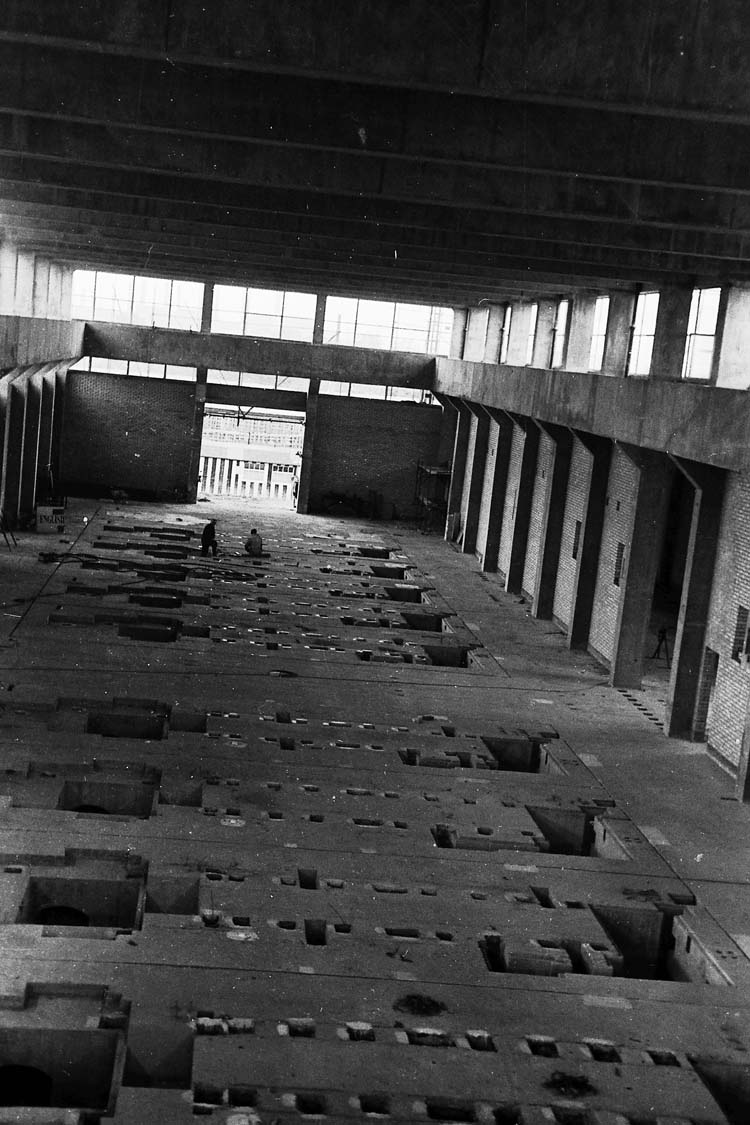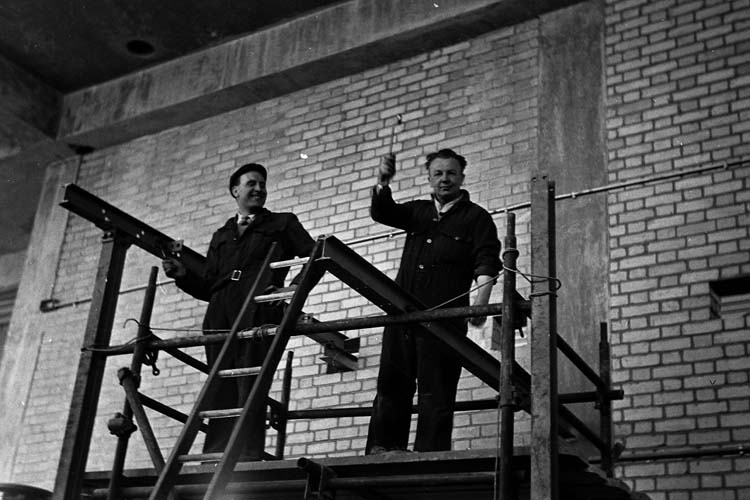Work experience of a young English Electric apprentice:
George Sayell at Crossness 1961
From 1957-62 I did a Student Apprenticeship with English Electric, Rugby, manufacturers of steam turbines and large slow revving static diesel engines for power generation. In the Spring and early Summer of 1961 I was sent down to the ‘Southern Outfall Works’ (Crossness) where the company was in the preliminary stage of installing diesel engines and associated equipment in the new power house. (In fact the power house was then an empty building. The engines would not have appeared until the following year). The engines were to be ‘dual fuel’ in that they would start up on oil and then run on methane gas.
During my time there I took a number of photos on 3 films, this script provides information on the films. It must be appreciated that these are my recollections after 60 years.
Film Folder 1
When I arrived at the site the E.E. team were in the process of refurbishing the two site huts (Mess room and Office). Photo (4A) shows them (L-R) Bob Morris (from Shropshire), ?, Eric Hill (E.E. Site Engineer, from Rugby), and Geoff ? (from Rugby). They were members of the ‘Outside Dept’, responsible for the installation, servicing and maintenance of the company’s products. As in Bob’s case they did not necessarily live in Rugby as they were assigned to a job (possibly for several years) where they lodged locally and only went home about one weekend in four. A senior engineer from Rugby visited the site about fortnightly to discuss the job and to liaise with the factory. Photo (7A) includes the ‘student apprentice’.
Photos (8A and 9A) show the inside of the Power House with the bases for the 10 engines and generators. Behind the ‘engines’ was a services bay in which would be installed the fuel and coolant tanks etc on frameworks. Below the service bay there was a basement. These photos were taken from the upper walkway. In (8A and 9A) note the two engineers working at floor level and part of an E.E. sign. The building seen through the open door is probably a site hut
Photo (33) shows the Ford works. Photo (34) is looking east towards Belvedere Power Station and a large site office building can be seen behind the pole. These photos were probably taken from a spot near the Power House.
The first job was to prepare the location points on each side of each engine on which the crankcase would stand. These points were about 10” x 5”. The soft surface of the concrete floor had to be removed by tapping with hammer and chisel, and then the area had to be made flat and level (no rocking) and with about 80% bedding to receive a metal plate on which the crankcase could be placed. The location points would have been shimmed as required to ensure the crankcase was level.
This of course was a filthy dusty task, carried out kneeling. H&S amounted to a handkerchief tied round the face and spectacles or any form of goggles if available. I recall that a grinder was acquired at one stage for preparatory work.
Other photos looking across the site and the river show the installation of the treatment tanks. There was a large industrial cement mixer on site and the only facilities I remember were a toilet block and a canteen that served meat pies and chips and little else. I was not made aware of a medical block, nor was I briefed on emergency procedures.
Film Folder 2
Photo (3A) shows the student apprentice at leisure! Leisure was rare as being away from home the team were working almost a seven day week. This suited me (as it did most apprentices) as the overtime coupled with the living allowance enabled considerable savings to be made over a few months!
Photo (5) shows the student apprentice erecting framework in the services bay. Photos (6 and7) are of Ernie and Bob Morris on the same task. ‘Ernie’ was a local welder-fitter taken on as a temporary employee. Note that my hat was the only H&S equipment in the photos, and probably on site!
Photo (8) looks across the river from near the riverbank.
Photo (32) shows the arrival of the overhead gantry crane from “Vaughans of Manchester”. A mobile crane ‘borrowed from the site’ is alongside. Note the careful positioning of the vehicles between the holes in the floor. It was E.E. responsibility to provide the labour to erect the crane under the guidance of ‘Charlie’, an installation engineer from Vaughans.
In photo (33) part of the overhead crane is being lifted off the transporter and in (34) Charlie (L) and Bob Morris are riding on it.
Film Folder 3
This film picks up the crane installation. Photo (1A) shows the first bridge girder being lifted up to the upper walkway and the end trucks placed on the runway rails on which the crane would run along the building. Bob Morris (?) can be seen leaning on the rail. Note that a different site mobile crane has been used. Again note the lack of H&S.
Photo (2) shows the second bridge girder (on the left) having been raised and is being fitted to the previous (on the right).
This operation almost cost me my life. I had been standing on the first bridge girder (no safety harness) to guide the raising and positioning of the second. The crane ‘jerked’ the part being raised such that it swung and struck the first part knocking me off balance. I immediately dropped flat onto the part I was standing on and hugged it with arms and legs, terrified. It took Charlie some time to get me back to the walkway and safety!
Photo (3) shows the trolley frame being raised, this would run along the top of the crane and across the building.
Photo (18A) is taken in the service bay showing the framework and the tanks etc.
One morning I saw that a mobile crane had fallen over following strong winds and I recall photographing the scene, photo (34A). The windows of the building on the right appear similar to those in the power house. The apparent height of the building and the location by the tank suggest that it is not the power house (from studying ‘google earth’).
Photos (35 and 36) I have no recollection of taking! It will have been at the old site. (35) is of the Centrifugal Pump House and (36) of the Crossley engines installed in 1948. I recall Bob Morris obtaining help from the ‘leading hand’ at the workshop one day and I may have been with him when we took these photos. The student apprentice is showing his delight in having found an engine!
I distinctly recall us looking in on the Beam Engine House one Sunday afternoon to find two ‘old boys’ looking after the site and despondent at the thought of it being demolished. Seeing the decaying Victorian ironwork I was utterly dismayed and it was this incident that created my interest in Crossness and industrial archaeology. It would be autumn 2019 before I saw Crossness again with a party from Warwickshire Industrial Archaeology Society.
Photo (36A) is of the new site.
Comments:
If the ‘1960s’ Power House still exists (and if so it is that which houses 6 MAN standby diesels) then it must be that seen on google earth with a pale blue roof in the centre of the site approximately 80M x 25M and lying roughly E-W.
I would like to know if there are any photos of the finished 1960s site and especially of the Power House showing the E.E. diesels.
I wanted to return to Crossness in 1962 but was sent to another sewage works under construction near Edmonton, this was updating an earlier works.
Copyright © (Text & Photos) G. Sayell October 2021
























